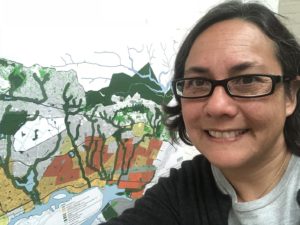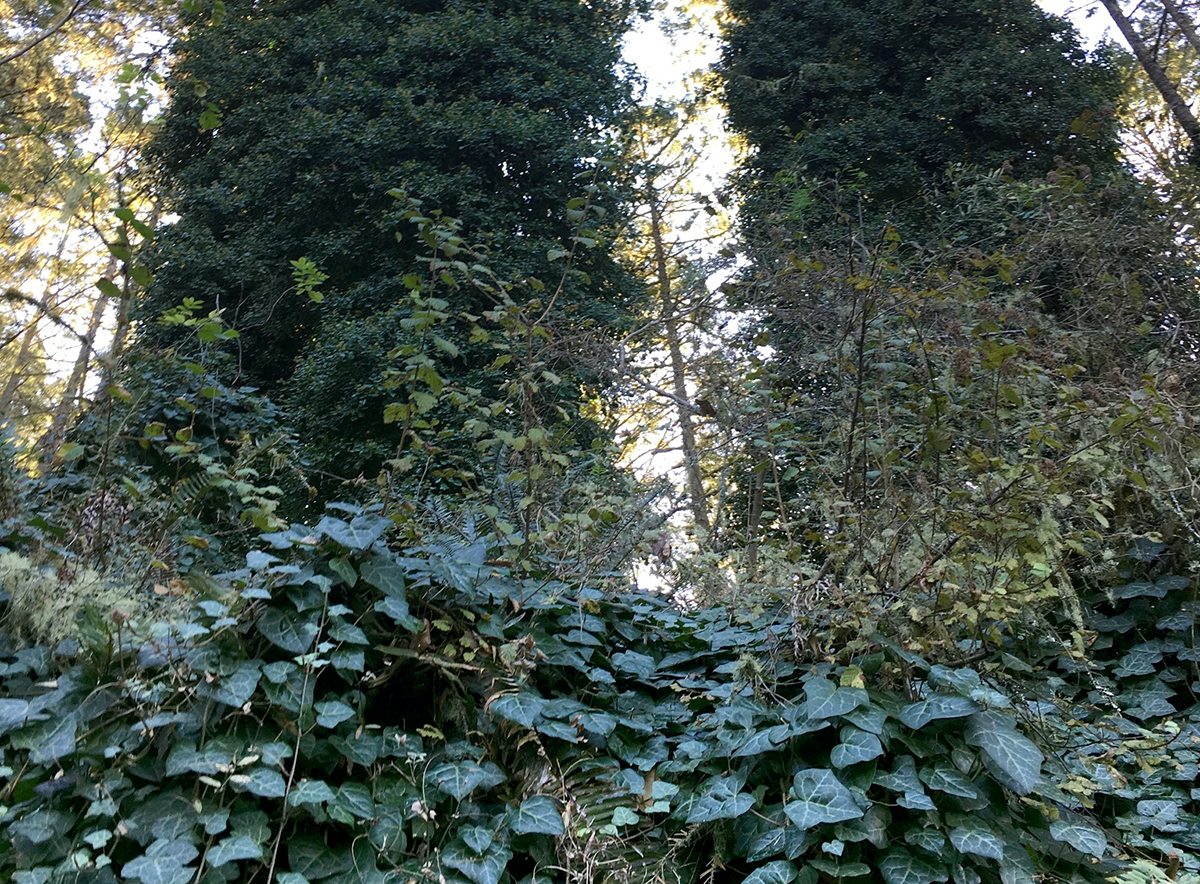I was recently hiking in the Sausal Creek canyon. It’s filled with ivy so prevalent that it reaches like long lianas up to two hundred feet, hanging from the top to the bottom of the canyon. But there are gorgeous bay laurels and oaks as well, and swordhead ferns. Hoping to help a Bay laurel that had only a bit of ivy starting up it–about twenty feet in extension–I started pulling off long curtains of ivy. The bark became exposed; acorns were caught in it, and about a quarter inch of a rich soil covered the bark since the trunk arced at an angle. I saw a black beetle, about half an inch long, skitter away. I realized that I had disturbed a little ecosystem in its own rights, and I’d just taken a comforting habitat from that beetle, and maybe other creatures as well. I’d really like to help protect these trees. My question is this: is it more beneficial for animals, trees, and plants in the long run to not pull the ivy off, or to pull it out? Thank you! –Dangling in Oakland
Hi Dangling in Oakland,
Your question brings up an interesting quandary — does removing a non-native species hurt wildlife? If your beetle was in the ivy, did you do it a disservice by destroying its home?
Ivy refers to ornamental vines that our earlier Victorian residents thought beautiful. There are a few species common to the Bay Area: English ivy, Canary Island ivy (a cousin to English ivy with larger, glossier leaves) and Cape ivy. All three are fast-growing vines, and quite hardy in our area. They replace native vegetation, including trees, shrubs and herbaceous plants, sometimes very rapidly. Ivy eliminates the ability of other plants to reproduce by outcompeting their seedlings for light. It smothers existing shrubs and trees by climbing and enshrouding them. These severe consequences in riparian corridors and woodland areas have earned ivies a “high” statewide negative ecological impact rating in the California Invasive Plant Council Inventory.
When invasive plants take over, not only is native plant biodiversity reduced, but many insect and animal populations suffer. The ground cover ivies produce reduces habitat quality for ground-feeding birds such as the dark-eyed junco, and spotted and California towhee. Ground-dwelling bees have more difficulty finding suitable substrates for their homes. Ivy does provide excellent cover for small rodents, especially rats in urban areas such as Sausal Creek, which can have further detrimental effects on nesting birds.
Some insects evolved with specific trees or shrubs such as madrones or oaks; their larvae feed on the leaves or flowers. The beetle you found in the ivy may have been a native beetle that relies on native species in some way. Or it may have been more of a generalist, not necessarily needing to live in a rich native-based ecology but participating in the small ecosystem the ivy and the bay tree were creating with pockets of soil and debris. These micro-ecosystems occur without the ivy in place, and your beetle is very likely to have been able to make a new home easily after disturbance – on wood or leaf debris on the ground, or moss on bark.
In general, if an invasive species has such a strong negative impact on biodiversity, it is beneficial to remove it. Currently the Cal-IPC is promoting responsible practices to reduce spreading such as trimming to prevent fruiting and to reduce seed dispersal by birds, and disposing of viable vegetation so re-rooting does not occur.
The Friends of Sausal Creek has an ivy removal team that meets the second Sunday morning of the month. They strip ivy from trees and remove understory English/ and Canary Island ivy. They also work on removing Cape Ivy in Joaquin Miller Park, so it doesn’t spread further into our watersheds.

Ask the Naturalist is a reader-funded bimonthly column with the California Center for Natural History that answers your questions about the natural world of the San Francisco Bay Area. Have a question for the naturalist? Fill out our question form or email us at atn at baynature.org!


